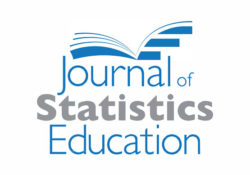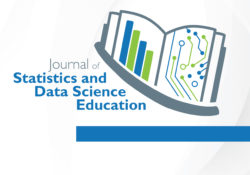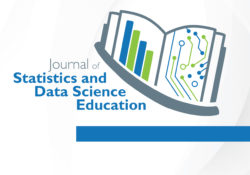tandfonline.com har udgivet en rapport under søgningen “Teacher Education Mathematics”: Abstract Formulae display:?Mathematical formulae have been encoded as MathML and are displayed in this HTML version using MathJax in order to improve their display. Uncheck the box to turn MathJax off. This feature requires Javascript. Click on a formula to zoom. Abstract Flipped classrooms have become an interesting alternative to traditional lecture-based courses throughout the undergraduate curriculum. In this article, we compare a flipped classroom approach to the traditional lecture-based approach to teaching introductory biostatistics to first-year graduate students in public health. The traditional course was redesigned to include video lectures and online quizzes which the students were expected to complete before coming to class, followed by a short in-class lecture and time working on applied statistics problems in class.… Continue Reading →
Like this:
Like Loading...
tandfonline.com har udgivet en rapport under søgningen “Teacher Education Mathematics”: ABSTRACT ABSTRACT “Flipping” the classroom refers to a pedagogical approach in which students are first exposed to didactic content outside the classroom and then actively use class time to apply their newly attained knowledge. The idea of the flipped classroom is not new, but has grown in popularity in recent years as the necessary technology has improved in terms of quality, cost, and availability. Many biostatistics instructors are adopting this format, but some remain unsure whether such a change would benefit their students. One potential barrier to adopting a flipped classroom is the common misconception that only a single approach is available. Having adopted the flipped approach in their own courses, the authors participated in an invited panel at the… Continue Reading →
Like this:
Like Loading...
tandfonline.com har udgivet en rapport under søgningen “Teacher Education Mathematics”: ABSTRACT ABSTRACT Online and flipped courses are becoming more commonly found across disciplines, including in (bio)-statistics. The literature contains many case studies of instructors reporting on their use of these formats. However, a gap exists in regard to a systematic study of instructors’ implementation of, attitudes on, and recommendations for online or flipped courses in (bio)statistics. We conducted a survey to elicit such responses, and we report here on n = 24 instructors who teach (bio)statistics in the health sciences. These instructors’ courses are described, as well as results summarized for their responses on various aspects of these courses, ranging from the technology they use to whether they would recommend various approaches to teaching colleagues. These findings should be useful… Continue Reading →
Like this:
Like Loading...
tandfonline.com har udgivet en rapport under søgningen “Teacher Education Mathematics”: ABSTRACT ABSTRACT It is very important for medical professionals and medical researchers to be literate in statistics. However, we have found that the degree of literacy that is required should not be identical for every statistical competency or even for every learner. We first begin by describing why the development, teaching, and assessment of statistical competencies for medical professionals and medical researchers are critical tasks. We next review our three substantial efforts at developing a comprehensive list of statistical competencies that can be used as a guide for what medical research learners should know about statistics, for curricular development, and for assessment of statistical education. We then summarize the origin and the inclusion of the statistical competency items. We follow… Continue Reading →
Like this:
Like Loading...
tandfonline.com har udgivet en rapport under søgningen “Teacher Education Mathematics”: Abstract Abstract Biostatistics is a critical skill to physicians in an evidence-based medicine era, but teaching basic statistical concepts is challenging. Students often experience anxiety caused by the complexity of statistics and might express negative attitudes toward the subject. We aimed to analyze the effect of an introductory biostatistics course using RStudio on attitude toward statistics and assess its acceptance among medical students. Forty-three 1st-year medical students were included. Pre- and post-course attitudes toward statistics were assessed using the Survey of Attitudes Toward Statistics (SATS-28) scale and technology acceptance was assessed by a Technology Acceptance Model scale at the end of the course. There was a statistically discernible (significant) gain in the scores of three of the four SATS dimensions:… Continue Reading →
Like this:
Like Loading...
tandfonline.com har udgivet en rapport under søgningen “Teacher Education Mathematics”: Abstract Formulae display:?Mathematical formulae have been encoded as MathML and are displayed in this HTML version using MathJax in order to improve their display. Uncheck the box to turn MathJax off. This feature requires Javascript. Click on a formula to zoom. Abstract Our study compared the performance of students enrolled in a graduate-level introductory biostatistics course in an online versus a traditional in-person learning environment at a school of public health in the United States. We extracted data for students enrolled in the course online and in person from 2013 to 2018. We compared average quiz and final exam scores between students in the two learning environments adjusting for demographic characteristics and prior academic performance using linear mixed models. Data… Continue Reading →
Like this:
Like Loading...
tandfonline.com har udgivet en rapport under søgningen “Teacher Education Mathematics”: Abstract Abstract Replication and reproducibility are an important component of scientific research. One reason research is not replicable is the misuse of statistical techniques. Educators can teach the importance of research replication by having students perform a replication study as part of a graduate assistantship or their coursework. In this article, we describe the components of a replication study, the process of conducting a replication study, and how to use the replication process as a teaching tool. Two biostatistics PhD students performed four full replication studies as part of their Graduate Assistantship and another 22 students performed a partial replication as their final project for a biostatistics service course. Students were queried for their feedback about their learning during the… Continue Reading →
Like this:
Like Loading...






